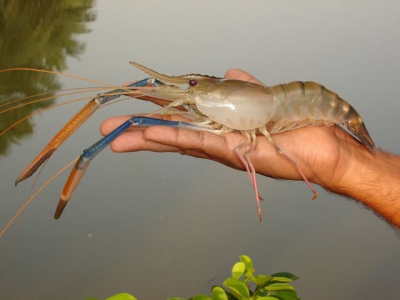Harvest method, live freshwater shrimp key to Sino Agros model

The firm behind what is being billed as the world’s largest shrimp farm is betting big on a proprietary harvest model and seemingly inexorable Chinese demand for live shrimp.
Since its announcement in 2014 that it planned to build a farm in Zhongshan, China theoretically capable of producing 300,000 metric tons of shrimp annually, Sino Agro Foods has kept busy with fundraising and construction for the ambitious project. The planned production of 300,000t by 2025 would put Sino ahead of Vietnam's total output.
The first phase alone is expected to cost $149.6 million, and the second phase $240m the company has said, with listings in US and Norwegian stock markets helping to finance construction.
But, the business model underpinning the project strays in several ways from what’s conventionally worked in aquaculture: It uses recirculating aquaculture system (RAS) rather than ponds; focuses on seldom commercialized freshwater prawns (Macrobrachium rosenbergii) rather than vannamei; and intends to sell those animals live at premium prices.
Additionally, the company’s method, which it calls the "A-power recirculating aquaculture system", relies on a “phased and partial harvest” system that cycles an rather than letting all of its shrimp grow to full size and harvesting them at the same batch, Tony Ostrowski, Sino’s chief scientific officer, told Undercurrent News in an interview earlier this year.
The harvesting method will allow for up to 14 growing cycles per year as opposed to two or three as is typically the case when outdoor ponds are used, Ostrowski said.
“There’s nothing really magic about the recirculating system. It has all the basic components that any other recirculating system would have — mechanical filter, UV filter, UV light, a little bit of ozone generation,” he said.
Partial harvest
Raising freshwater animals means less wear-and-tear on a RAS operation compared to relying on saltwater, he said, but the recirculating technology is not overly novel, he said.
“The magic is not here,” he said, tapping his finger against a diagram he drew of the set up. “The magic is in our strategy.”
That strategy includes grouping shrimp at different stages of development and starting new batches much more frequently than tradition pond aquaculture.
“We put a batch of animals in here like this. We grow them for a certain period of time and transfer them there,” Ostrowski said, referring to the next tank.
“They’re transferred over, we put another batch in, and we keep going from there, and restock the tank," he said.
By using the method the company isn’t able to fully grow out all of its shrimp, Ostrowski said, but the rapid turnover in production cycles means that the the potential loss in revenue is more than made up for by processing more batches.
“It’s yield maximization,” he said. “We’re turning over very quickly.”
RAS facilities, because they are covered and can better exclude disease, feature greater survivability rates compared to ponds. They also maintain a stable temperature and conditions that reduce stresses on shrimp and encourage more efficient feeding methods, Ostrowski added.
However, RAS hasn’t always been profitable at scale or offered particularly high returns on investment relative to the capital costs needed, but Sino Agro believes that the yield maximization will overcome these issues.
Macrobrachium
The choice of species is another way in that the Sino Agro project differs from the norm.
Traditionally, macrobrachium haven’t been the major focus of the global shrimp industry. Only about 400,000t of the species are produced annually, and 80% of that figure is farmed in China, Ostrowski said.
But the shrimp are typically raised in large open ponds with “much, much lower” stocking rates compared to vannamei, sometimes as low as 10 animals per square meter compared to vannamei’s 150 animals per square meter, he added.
The reason for the discrepancy is that individual macrobrachium grow at different rates
“Females don’t grow very big and they grow pretty uniformly in size. The males however, big differences in size,” he said.
Some larger males known as blue claw males can stunt the growth of other animals which accounts for the lower densities, but the company plans to minimize that problem by keeping similarly sized shrimp in the same tanks, Ostrowski said.
The company also aims to ensure profitability by capitalizing on the market for live shrimp in China which avoids processing and maximizes the product’s value by weight, Ostrowski said.
“For macrobrachi there is no market for frozen macrobrachium in China, it’s all either live or fresh” adding that 90% of the market is for live animals.
He believes that live macrobrachi will fetch $15 per pound once production ramps up, based on observations that the species sells for $22 per kilo at some low-end markets, he added.
Related news
Tools

Phối trộn thức ăn chăn nuôi

Pha dung dịch thủy canh

Định mức cho tôm ăn

Phối trộn phân bón NPK

Xác định tỷ lệ tôm sống

Chuyển đổi đơn vị phân bón

Xác định công suất sục khí

Chuyển đổi đơn vị tôm

Tính diện tích nhà kính

Tính thể tích ao



 Stirling researchers identify viable ablation alternatives for shrimp…
Stirling researchers identify viable ablation alternatives for shrimp…  Freshwater shrimp farming would help control deadly parasitic…
Freshwater shrimp farming would help control deadly parasitic…